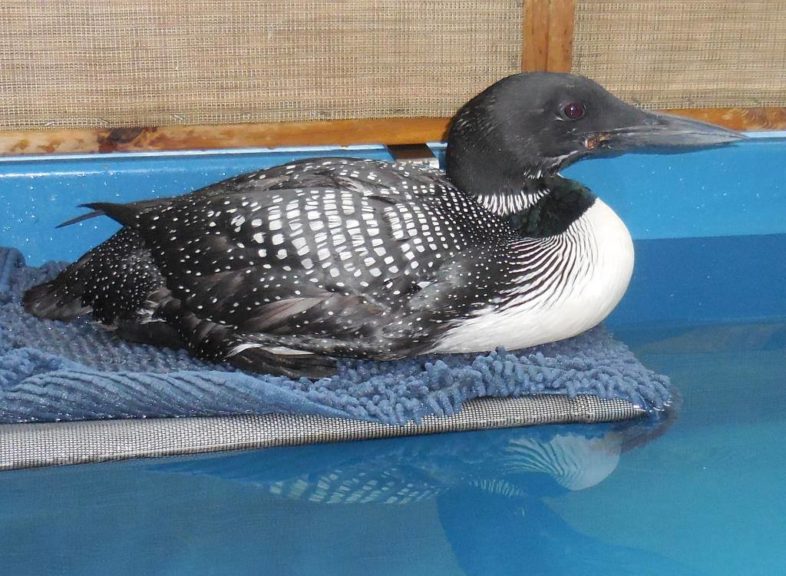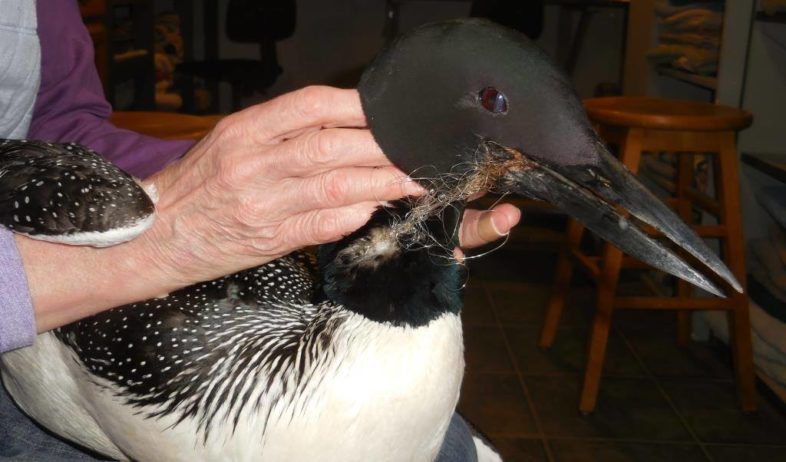By Nate Launer, VCE Alexander Dickey Conservation Intern
The phone rang on Friday afternoon and VCE loon biologist Eric Hanson had just received word of a loon on Sabin Pond in Woodbury, entangled by fishing line and in poor condition. With the evening’s forecast looking good, Eric decided it would be best to investigate at dusk; if a rescue was necessary, that would best be done after dark. I was full of excitement; this would be my first time taking part in a loon rescue, an opportunity I hoped would present itself during my summer as VCE’s Alexander Dickey Conservation Intern.
I arrived at Eric’s house and we loaded the truck with gear necessary for the capture. If we needed to capture the loon, we would employ a tried and true method that Eric has used many times before and requires a great deal of experience. We would fix the loon in a spotlight on the water after dark, and then slowly approach with a boat and net it by hand. Since I began work with the Vermont Loon Conservation Program (VLCP) in late May, I wondered how these large, diving birds were best captured so that they could be safely handled; I was eager to observe the spectacle. With the canoe and larger capture boat loaded in the truck, spare batteries, the large capture net, and a tackle box full of banding tools, we were ready to go. Together with a friend and enthusiastic volunteer, Susan from Craftsbury, we set out for Sabin Pond.
Arriving just before sunset, the two lakeshore residents who had reported the loon met us at the boat launch, and offered to help if they could. Their concern and enthusiasm was palpable, and reflects something I have observed almost daily in the course of my internship. Local residents and property owners have consistently been interested in our work, and eager to help in any way. The care and generosity that people have demonstrated for loons has repeatedly amazed and inspired me, and explains the success of this long-term conservation project. We thanked them for their help, and explained that we were simply going to scout out the situation with the canoe first.
Once on the water, we immediately located a loon which appeared to be the bird in trouble. As we approached, it remained where it was. Seemingly lethargic, it did not dive to keep its distance from boaters as loons usually do. A loon’s diving behavior often gives clues as to its health. A healthy adult loon will spend, on average, 30-40 seconds underwater on a single dive to forage for fish. Observing drastically shorter dive lengths, especially by a loon exhibiting otherwise abnormal behavior, may indicate that it is underfed, low on energy, or otherwise unhealthy. With these observations noted, we decided to scout the rest of the lake and return to check on its condition after we had done so.
Soon after, we observed a sub-adult loon. Its diving activity was normal and frequent, suggesting that it was likely not the bird in distress. Our target loon had been reported in a small bay earlier that day, so we paddled into the bay, scanning the shores with binoculars. With no loon in view, we decided to return to check on the first. This time however, we found it to be diving frequently and seemingly behaving as a healthy loon would. Eric considered the options aloud, for my benefit: If this was the distressed loon, might it have swallowed and passed the fishing line? Not likely, our bird was reportedly in visibly poor condition. Eric decided that we should turn back and check more thoroughly the bay where the distressed loon had been reported once more. He had a gut feeling that the loon might still be there.
Paddling into the bay, we hugged the shoreline and carefully scanned the area. Rounding a small point of land, we finally found it. The loon had beached itself and was sitting behind a bush on the lakeshore. Staying on land, other than to incubate a nest, is highly unusual behavior for these aquatic birds, so this was a clear indication that we had found the injured individual. We quickly organized our rescue plan, and as I steered the canoe closer, Eric expertly captured the loon with a quick swing of the net. Examining its injuries closely, it became clear that the bird would need a great deal of help. The fishing line, which it had swallowed, was tangled around its tongue, bill, and neck. The line had abraded some feathers and cut deeply into its mouth. Eric decided that this loon needed to be brought in right away, so we paddled back to the truck, situated it safely in a cage with some towels to keep it comfortable, and drove back to the house. When we arrived, Eric called a bird rehabilitation center in Maine, and they suggested that we bring it to a center called the Avian Haven the following morning.
The four and a half hour trip to Avian Haven in Freedom, Maine, was worth every mile. When I arrived, I met the entire team and they put me right to work. They showed me how to properly hold the loon while they took x-rays, a blood sample, and removed the tangled line from its mouth and neck. The results of the blood sample showed that the bird had low protein levels and severe anemia, suggesting that it had not eaten for quite some time. Luckily, however, the blood test did not indicate lead poisoning, a constant fear when birds swallow line that could possibly have old lead sinkers attached to it. Once the fishing line was removed, the loon settled into an indoor pool. To me, the bird looked quite a bit more relaxed, and I was glad to leave it in the capable hands of the amazing people at Avian Haven.
It was an unforgettable experience for me, and one I suspect I will always look back on as a pivotal moment on my conservation career path. It was satisfying to be involved in both the rescue on the lake and the clinical evaluation at the rehab facility, to see the process from start to finish, and to monitor the loon’s recovery via updates from the Avian Haven.
Our colleagues at Avian Haven report that our rescued loon is now “eating voraciously” and recovering well. To add to the good news, nesting loons have been observed on Sabin Lake in Woodbury within the past week. This means we can thus conclude that the bird we rescued was not part of the breeding pair, leaving a good chance for successfully nesting on the pond. I am excited to check back in with our loon soon, and for the many future adventures out on Vermont’s lakes with these beloved birds.



We thoroughly enjoyed this account …and it is a relief to hear that the efforts of VLCP were once again successful !…..for those who truly care about loons and loon conservation, a huge THANK YOU! ……henry and sherry
Once again, the team work of caring individuals who reported the doomed loon, fabulous dedicated VCE scientists, and amazing healers at Avian Haven have given another bird a second chance! Thank you Eric for being so thorough in your search AGAIN (I am thinking of a special loon you rescued in Brighton, VT in August 2 years ago). Your work is so vital and it’s success is obvious with the recovery of loons in Vermont over the years. And thanks to Avian Haven AGAIN for your amazing facility and staff who will undoubtedly see this loon gets back to a normal life soon!
What a wonderful account with a happy ending. Somehow fishermen should be encouraged to try and retrieve line that was not the right test for the fish and snapped. And never ever to discard tangled line into the water.
Congratulations to Nate on this detailed report. It is encouraging to know that he is entering the conservation field.
As I read this I felt sadness and anger that the loon had to suffer because of human disrespect/disregard. I also felt so glad the loon will recover because of human compassion. One creature at a time, I believe that is how we make a difference.
Nate, glad you had the opportunity to have this experience. It’s heartbreaking to see a sick loon or one that is in trouble. So many people, from the bottom up, starting with the nameless number of volunteers that fret and worry, who end up spending countless hours monitoring these birds know what you are talking about…The end results seems to have paid off. That’s what we are all here for, (VLCP) to do what we can to help them out when they need help. Thank you
Nate, what a well written and fascinating account. Thank you so much. I felt as though I were there. Eric’s and your dedication and skill saved this loon. Is there a fisherman’s organization to whom you could send this story? It’s so well written and nonjudgemental – just the facts. It would be valuable for that community to learn about a specific instance and how it was resolved.
Beautifully written story. I am very pleased that VCE internship gave you this memorable moment in your conservation career path.